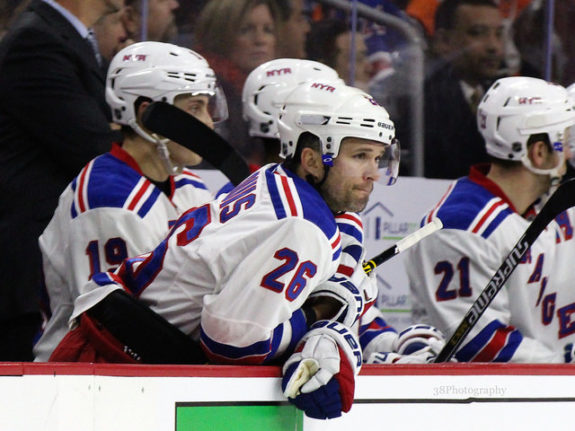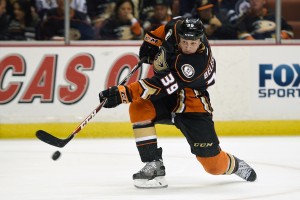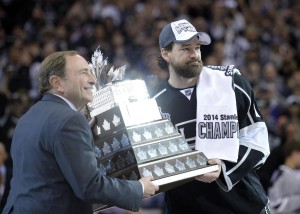Every summer we get a handful of players who go to free agency and get paid better than they probably should. They’re the players that get complained about for the next season (or two, or three). There are a lot of reasons this happens.
Sometimes they get the contract because of an impressive performance in a small sample that makes a GM think they’re getting a budding superstar when it’s really a small amount of variance — maybe a high shooting percentage — that has boosted the player’s short-term value. (Matt Beleskey?) Maybe it’s a player on the decline due to age with an impressive track record. (Martin St. Louis?) Maybe the GM thinks they’re buying veteran leadership or a player who has hoisted the Cup and that this action has value to a team in the present. (Justin Williams?) Sometimes it’s just market forces at work, like last summer when high demand for defensemen and a dearth of options led to lots of defensemen getting hefty contracts.
There are lots of reasons teams overpay. Here are 11 players who are likely to be overpaid this summer if and when they hit free agency on July 1.
1. Martin St. Louis
last contract: 4 years, $5.625M
Don’t get me wrong, Martin St. Louis is great. He should find his way into the Hall of Fame after he retires and he probably has another year or two in him. Though, at 40, retirement won’t be out of the question. But if he does play, it’s clear that teams are going to be getting diminishing returns. He put up 30 goals last year and 21 this year, which is nothing to sniff at, but is well below the kind of production we associate with the dynamic winger.
Last year, after he moved to the Rangers, he struggled to produce, scoring a single goal in his first 17 games there. But once the playoffs came around he became a key piece of the puzzle, potting eight goals and seven assists through 25 games. This season, his regular season numbers were down and he is struggling to produce in the postseason, going without a goal in the postseason’s first 15 games.

St. Louis can still produce, but the diminutive forward is going to be 40 at the start of the 2015-16 season and he is likely to be paid based on his name and his history and not the downward trend his production is on.
2. Curtis Glencross
last contract: 4 years, $2.55M
The Capitals moved to grab Curtis Glencross at the trade deadline sending second and a third round pick to Calgary in exchange. It looked like a brilliant move briefly. Glencross scored three goals and two assists in his first five games with the Caps. Over the next 13 games he had one goal and one assist, including a 19-game goalless drought that stretched into the postseason. Glencross even found himself scratched during the playoffs.
During his time in the nation’s capital, he had the team’s lowest regular season shots for per 60 minutes of even strength play (SF/60) by over a shot and a half, which was accompanied by a -3.31% score-adjusted CF%Rel (his Corsi relative to how the team performed when he wasn’t on the ice, adjusted for score-effects) in Washington and a -1.1% mark on the season. He’s had a negative relative Corsi in three of the last four years and his production is on the decline.
However, at 32 and with his history, there will be teams interested, hoping he can rekindle his scoring touch. Those teams will also believe in his reputation as a two-way winger. But with production on the decline at both ends of the rink and the risk of his propensity for injuries dulling the grittier aspects of his game, he could be getting paid far more than he’s worth.
Nine seasons into his career, he’s only made the playoffs twice, so he may be faced with a decision of bigger money with a struggling team or a pay cut to go to a contender.
RELATED: Curtis Glencross Won’t Save Your Team
3. Cody Franson
last contract: 1-year, $3.3M
Outside of his first two NHL seasons, the first time he played for Nashville, Cody Franson has been on a Toronto team that struggled to drive play. So while the raw numbers aren’t astonishing, it’s notable that he has posted a positive CF%Rel every season of his career.
He’s a defenseman who can drive play and create offense, posting 36 points (7-29–16) this season. He didn’t play many minutes on Nashville’s very deep blue line, but he was north of 20 per game with Toronto before getting traded.
He’s only 27 and it’s a thin market for teams that are looking to immediately improve on defense. His size — 6’5″, 213 — will separate him from the free agency pack for teams who are hoping to sign a utility-knife defenseman. They’ll be hoping that his decent production, size, and possession skills mean a they’re getting more than meets the eye.
With a thin market for defensemen and how defensemen have been paid the last couple of years in free agency, it could mean a nice raise for Franson.
Cody Franson in Nashville:
Corsi rel: +3.9%
On-ice S%: 5.5%
— Draglikepull (@draglikepull) April 30, 2015
RELATED: Nashville Predators Free Agents: Who Stars, Who Goes?
4. Chris Stewart
last contract: 2 years, $4.15M
Chris Stewart had a rough couple years. He was moved from St. Louis — a team he clearly liked and harbors bitterness toward over the trade — to the lowly Buffalo Sabres, where his numbers plummeted and he didn’t look like the Stewart that looked so promising for the Blues in the lockout season.
But as we’ve seen not only with Stewart, but Drew Stafford, Tyler Myers, and, to some extent, Torrey Mitchell, the numbers in Buffalo aren’t just dragged down by a terrible team. Veterans on the team seem to have lacked motivation and couldn’t get over the crushing disappointment of playing for a team who is setting you up to fail.
With how some of these guys have performed since leaving Buffalo (Stewart: 1.1 points per 60 minutes of even strength play — or P/60 — and -2.9% CF%Rel in Buffalo, 2.2 P/60 and 6.8% CF%Rel in Minnesota), you have to wonder if they haven’t wasted some of their prime years languishing on a team that didn’t care about the product on the ice. That probably goes double for guys who were there longer, like Stafford, Hodgson (still there), and Myers.
Stewart rebounded nicely and fought hard for the Wild. He disappeared a bit in the postseason while playing through injuries, but he was a hard-nosed, possession-driving wing for the Wild when they needed exactly that. He was going to get a nice pay-day this summer anyway, but GMs trying to read the tea leaves in his small sample with Minnesota may be willing to spend extra to get him.
On the other hand, after his experience in Buffalo and St. Louis, Stewart may take less money to play on a team that will win and that will give him a no trade clause.
RELATED: A Look at Minnesota’s Free Agents
5. Karri Ramo
last contract: 2 years, $2.75M
Karri Ramo may be the benefactor of a somewhat thin goaltending market this summer. For top-tier goaltenders there’s really only Antti Niemi and Devan Dubnyk, with the latter likely to re-sign in Minnesota.
After those two there is a pile-up of goaltenders like Ramo, Anders Lindback, Jhonas Enroth, Viktor Fasth, Jonas Gustavsson, Ray Emery, Michal Neuvirth, and Thomas Greiss, any one of which would be a bit of a roll of the dice for a starting job, but would make a comfortable back-up.
However, Ramo may have separated himself from the pack, posting the best Sv% of his career at .912 (he looked fantastic some nights) and was called upon to get into seven playoff games, despite Jonas Hiller being the “starter.” If Ramo has separated himself enough — which of those goaltenders had a particularly great season? — he could find himself getting a solid payday from a team that is looking for a starting goaltender on the open market. (Sharks? Stars? Sabres? Oilers?)
6. Matt Beleskey
last contract:2 years, $1.35M

He’s making the case this postseason to be Justin Williams lite. He had a career year and is topping it off by being the kind of depth player that is key to a deep playoff run.
His 22 goals this season double his best year ever and his 35 points are also a career-high. He’s averaging a half point per game in the playoffs, buoyed by a five-game goal streak and a six-game point streak. Even his advanced stats bounced upward this season. He’s been a negative relative possession player every year of his career until this year where he posted a scored-adjusted CF%Rel of 4.3%. (Last season he tics just over 0 when his CF%Rel is score-adjusted, it’s negative otherwise.)
Beleskey is only 26 and, particularly if the Ducks make the Cup finals or even win, could find himself looking like a player on the rise with great postseason experience.
7. Antoine Vermette
last contract: 5 years, $3.75M
Antoine Vermette had been a pretty reliable 20-goal scorer for the Coyotes, but with this season’s performance and his age, 32, it certainly raises questions about whether or not he’s on the decline or could thrive in a new situation.
On the season, he scored 13 goals, which is low, but looks worse when you separate out how he performed on a very deep and talented Chicago Blackhawks team. He didn’t manage to score a single goal with Chicago through 19 regular season games. Vermette has not looked like the star they thought they were acquiring. He was scratched at the start of the postseason and again in Round 3.
Antoine Vermette on being a Game 3 scratch: "I’m not going to lie. I was not happy with that." #Blackhawks
— Chris Kuc (@ChrisKuc) May 22, 2015
He’s posted negative score-adjusted CF%Rels for the last three years and production is on the decline, but there aren’t many options out there for teams looking to add scoring. Vermette could see a contract around what he’s currently making and that’s going to be too high for the kind of production he provides at this point in his career.
8. Carl Soderberg
last contract: 3 years, $1.008M
Carl Soderberg is far from a guarantee to get overpaid, but there’s a scenario where it’s easy to see how this plays out. He’s been a late-bloomer, playing in only his second NHL season this year at age 29 (he’ll be 30 at the start of next season), but he’s been a great producer for Boston, putting up 44 points this year (13-31–44) and 48 last year (16-32–48).
However, Boston has some serious cap issues and Soderberg is going to need a raise. He may want to stay, but if something isn’t worked out by July 1 it’s not hard to see other interested parties make an offer that’s a little north of what he’s worth just to make sure that Boston wouldn’t be able to match it.
It’s a thin market and centers don’t grow on trees.
RELATED: Free Agent Debate on Carl Soderberg
9. Justin Williams
last contract: 4 years, $3.65M

Justin Williams probably won’t be winning with the Los Angeles Kings again next season. They have nine players making over $4M per season and eight of those nine contracts last through the 2018-19 season. (They have one more $4M contract that lasts to 2018-19 if you include Slava Voynov, who is still going through the legal system for charges of domestic abuse.) They don’t have much flexibility.
With their lack of cap space or flexibility, it might be hard for them to re-sign Mr. Game 7. That’s probably ok for Los Angeles who has a number of young players due raises soon and may not want to lock up their roster with players over 30. But there will be plenty of teams interested in a former 30-goal scorer who put up 25 points in 26 playoff games en route to his third Stanley Cup victory and a Conn Smythe award at age 32.
Williams will be a hot commodity, possibly for younger teams looking for veteran leadership and a veteran who has hoisted the Cup before.
REALTED: Kings 2014-15 Season in Review: The Wingers
10. Jeff Petry
last contract: 1 year, $3.075M
Jeff Petry may be the most sought after defenseman in free agency. He’s versatile, he has good size at 6’3″, he can put points on the board, he had the best offensive season of his career last year, he contributed in the playoffs, and looked like one of the few trade deadline acquisitions that wasn’t a bust.
With the way defensemen, particularly the top handful of guys in any class, have been valued and been paid, Petry could wind up with a hefty price tag, should he decide not to re-sign in Montreal prior to July 1.
"Jeff Petry is a priority for us. I think he fits perfectly with our team. He played some big minutes for us." – Marc Bergevin #GoHabsGo
— Canadiens Montréal (@CanadiensMTL) May 15, 2015
RELATED: The Argument for the Habs to Keep Jeff Petry
11. Mike Green
last contract: 3 years, $6.083M
Mike Green is going to be viewed as one of the top defensemen in the free agent class and is in line for a big paycheck, particularly considering what he was making in Washington. However, the days of Green scoring 30 goals and putting up 70 points are gone.
His production is decreasing. While he posted the most points he’s had since the 2009-10 season and also had his best P/60 (1.3) since then, injuries cutting his prime years short regularly is a concern.
His track record will get him paid, even if he’s coming off something of a weird season where his P/60 rose and his responsibilities shrank. He was supplanted as one of the team’s top defenseman and was even relegated to the third pairing at times. He averaged 14.8 minutes of even strength ice time per game, the lowest since his sophomore year in 2006-07.
Green is a bit of a mystery. His production has slowed, but it wasn’t a terrible year despite it’s oddities. I wouldn’t bet against a decent season next year, but he’s not a $6.083M guy. He won’t get that kind of deal in free agency, but it might not be all that much lower when the ink dries.